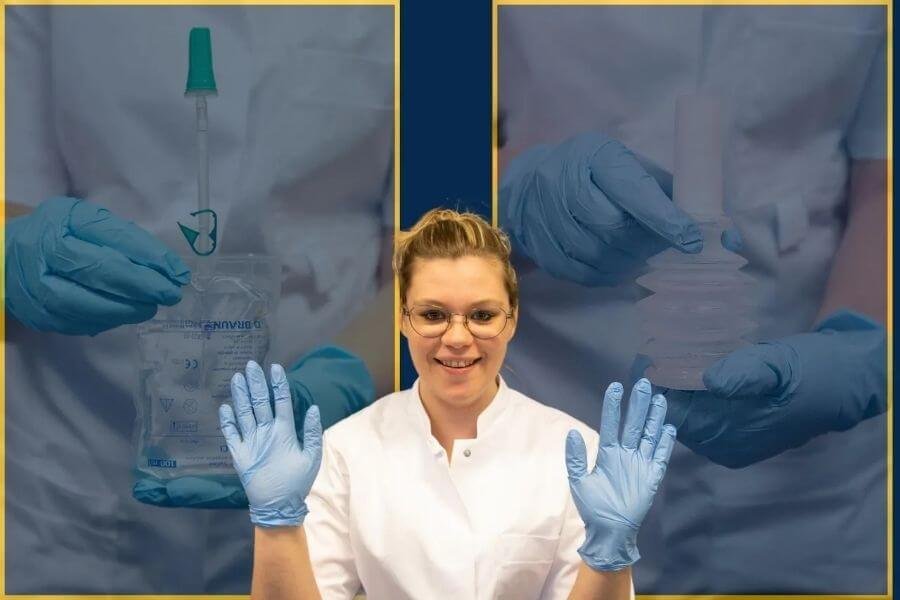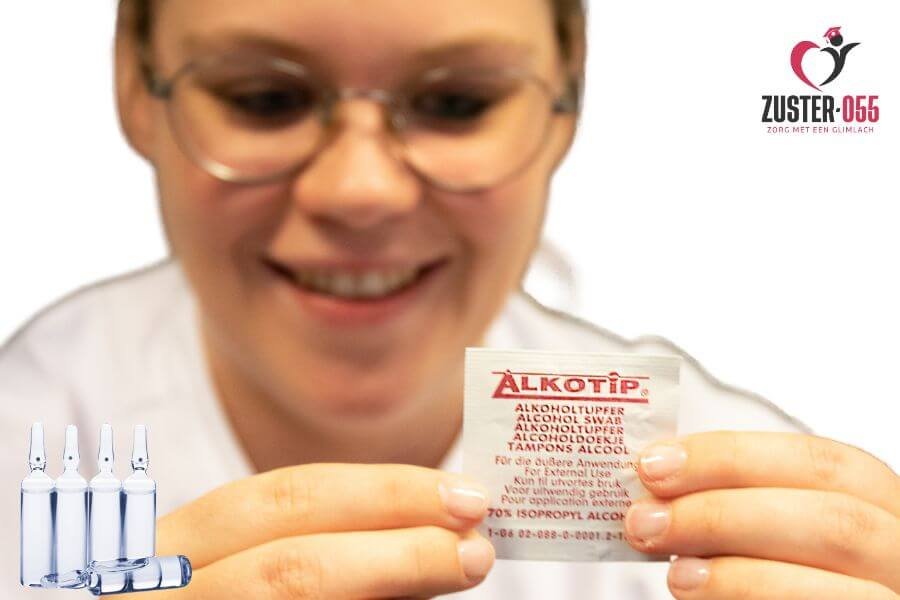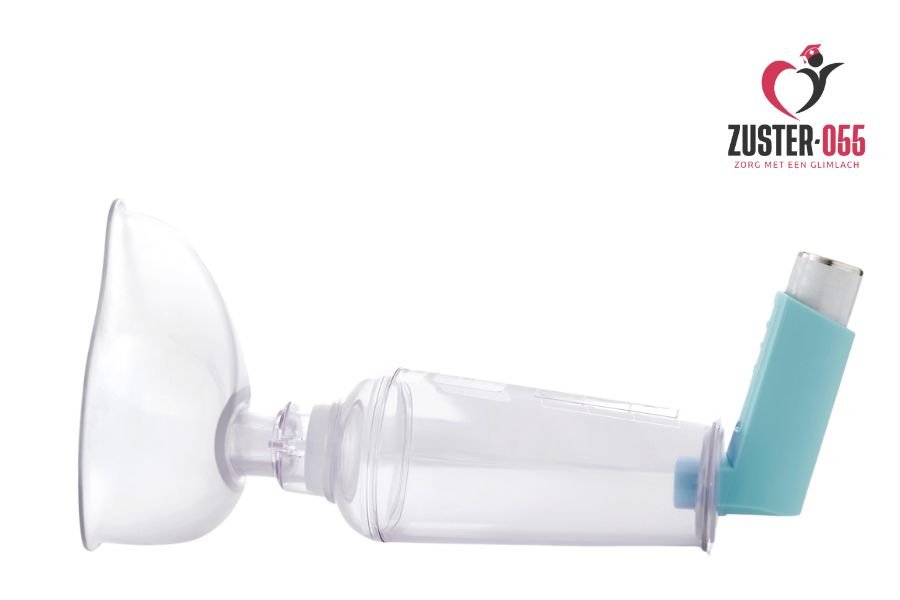Currently Empty: € 0,00
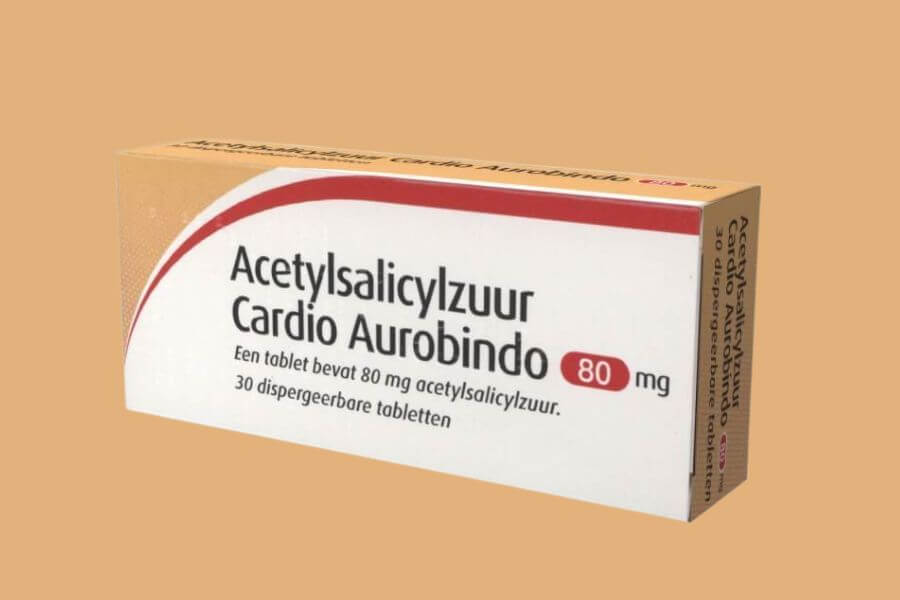
Acetylsalicylzuur is een antistollingsmedicijnen. Het zorgt ervoor dat het bloed minder snel samenklontert. Hierdoor vermindert de kans op . Trombose is een aandoening waarbij bloed in de vaten stolt zonder wondje of waarbij een al ontstane bloedprop te groot wordt en soms zelfs losschiet en een bloedvat afsluit. Daarnaast wordt Acetylsalicylzuur ook voorgeschreven na een hartinfarct, een beroerte, bij hartfalen en bij een eerdere trombose. Dit laatste wordt gedaan om herhaling te voorkomen. Door het slikken van Acetylsalicylzuur plakken bloedplaatjes minder snel aan elkaar, zodat het minder klontert.
Kort samengevat. Acetylsalicylzuur:
- Wordt gebruikt voor: het voorkomen van trombose
- Het Effect: bloedplaatjes plakken minder snel aan elkaar, waardoor minder klontering ontstaat
- Werkzame stof: Acetylsalicylzuur
Praktijk
In de praktijk zien wij heel vaak dat zorgverleners en zorgvragers niet goed op de hoogte zijn van de juiste inname bij Acetylsalicylzuur. De één kauwt er op, de ander slikt hem heel door en een volgende lost hem op in het water. Eigenlijk doen wij allemaal maar wat. Maar wat is nu de juiste manier? Wij geven je het juiste antwoord!
Oplossen in water!
Gebruik Acetylsalicylzuur altijd precies zoals de arts of apotheker het voorschrijft. Twijfel je over het juiste gebruik, neem dan altijd contact op met een arts of apotheker. Doe de tablet in water (1/2 glas) en laat hem uiteen vallen. Roer goed door en drink daarna de opgeloste tablet met water op. De tabletten kun je het beste `s morgens op de nuchtere maag innemen of tenminste een half uur voor de maaltijd om zo snel mogelijk effect te hebben.
Waarom oplossen in water?
Uit diverse onderzoeken (zie referenties) is gebleken dat het gebruik van geneesmiddelen vaak voor een beschadigde slokdarm zorgt. In het geval van Acetylsalicylzuur heeft dit met de zuurtegraad te maken. Dit noem je ook wel PH-waarde. De slokdarm kan het medicijn niet goed verwerken bij het heel doorslikken van de tablet. Als acetylsalicylzuur dan te lang in de slokdarm achterblijft, of deeltjes daarvan, dan kan het de slokdarm beschadigen.
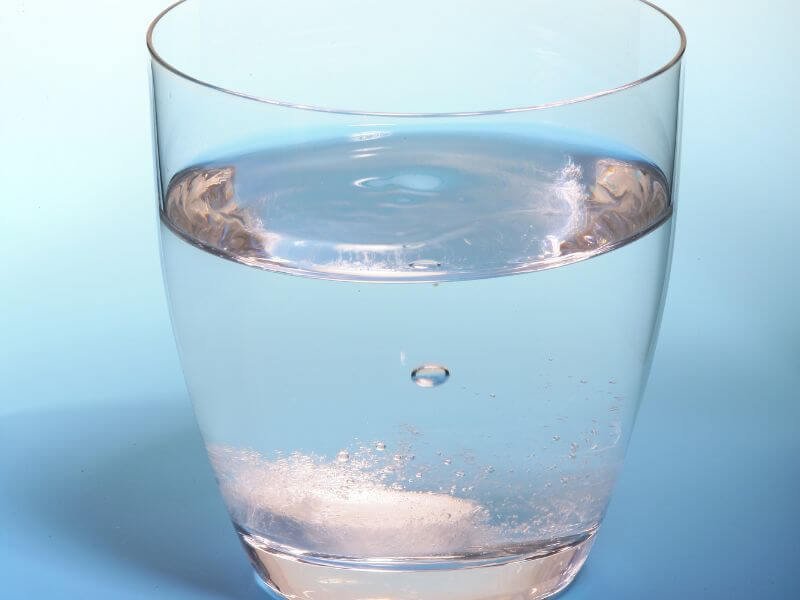
Hoe herken ik dat tabletje tussen alle andere?
Vaak hebben ouderen een baxtersysteem voor de medicatie. Maar hoe herken ik nu dat tabletje?
Het Acetylsalicylzuurtabletje is gemakkelijk te vinden en is te herkennen aan:
- De 80 (van 80mg) die op de achterkant van de tablet staat
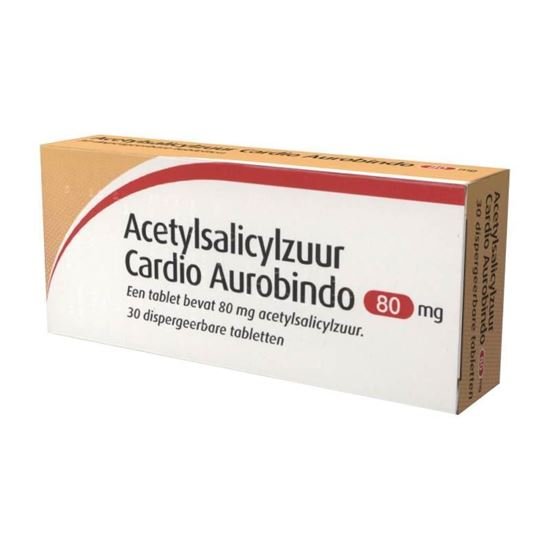
Conclusie
Lees altijd eerst goed de bijsluiter, bij twijfel raadpleeg dan altijd een arts. En voor in de toekomst…. altijd de acetylsalicylzuur oplossen in water!
Link naar de bijsluiter: Bijsluiter Acetylsalicylzuur
Referenties, bronnen, literatuur
- Merkus FWHM. Slokdarmbeschadiging door doxycycline entetracycline. NedTijdschr Geneeskd 1977; 121: 2060-1.
- Strouthidus TM, Mankikar GD, Irvine RE. Ulceration ofmouth due to emepronium bromide. Lancet 1972; i: 72-3.
- Stricker BHCh. Ernstige slokdarmbeschadiging dooremepronium-bromide (Cetiprin). NedTijdschr Geneeskd 1982; 126: 588.
- Puhakka HJ. Drug-induced corrosive injury of theoesophagus. J Laryngol Otol 1978; 42: 927-31.
- Carlborg B. Complications when drugs accidentally dissolvein the oesophagus and bronchi. Läkartidningen 1976; 73:4201-4.
- Crowson TD, Head LH, Ferrante WA. Esophageal ulcersassociated with tetracycline therapy. JAMA 1976; 235: 2747-8.
- Burrington JD. Clinitest burns of the esophagus. AnnThorac Surg 1975; 20: 400-4.
- Goldman JL. Esophageal obstruction from a hygroscopic gumlaxative (Saraka). JAMA 1937; 108: 1408-9.
- Waltz MR. Esophageal obstruction resulting from aninjudicious method of ingesting a hygroscopic gum laxative (Saraka). JAMA1939; 112:229.
- Voinchet O, Mouchet A. Obstruction de l’oesophagepar mucilage. Nouv Presse Méd 1974; 3: 1223-5.
- Sandeman DR, Clements MR, Perrins EJ. Oesophagealobstruction due to hygroscopic gum laxative. Lancet 1980; i: 364-5.
- Roux E, Nicole A, Capitaine Y. Complication aigued’un traitement par laxatif mucilagineux. Schweiz Med Wochenschr 1984;114: 1470-2.
- Lyden E, Spandow O. Totalstopp i esofagus efter intag avbulklaxativ. Läkartidningen 1981; 78: 4456-7.
- Henry DA, Mitchell AS, Aylward J, Fung MT, McEwen J,Rohan A. Glucomannan and risk of oesophageal obstruction. Br Med J 1986; 292:591-2.
- Newburger PE, Cassady JR, Jaffe N. Esophagitis due toadriamvycin and radiation therapy for childhood malignancy. Cancer 1978; 42:417-20.
- Hemstreet MPB, Reynolds DW, Meadows J. Oesophagitis. Acomplication of inhaled steroid therapy. Clin Allergy 1980; 10:733-8.
- Riddell RH. The gastrointestinal tract. In: Riddell RH,ed. Pathology of drug-induced and toxic diseases. 1st ed. Edinburgh:Churchill-Livingstone, 1982: 515-606.
- Lubicz S, Shafir M, Diamond S, Monosan R, Cohen C.Mallory-Weiss syndrome secondary to cis-platinum chemotherapy: an unusualcomplication. J Surg Oncol 1982; 20: 247-9.
- Timberlake GA. Ipecac as a cause of the Mallory-Weisssyndrome. South Med J 1984; 77: 804-5.
- Dumas D, Faux N, Levillain Cl, et al.L’hématome intra-mural spontane de l’oesophage. Uneobservation au cours d’un traitement anticoagulant et revue de lalittérature. Méd Chir Dig 1983; 12: 47-50.
- Herman TE, Kushner DC, Cleveland RH. Esophageal stricturesecondary to drug-induced toxic epidermal necrolysis. Pediatr Radiol 1984;14: 439-40.
- Marvola M, Vahervuo K, Sothmann A, Marttila E, RajaniemiM. Effect of dosage form and formulation factors on the adherence of drugs tothe oesophagus. J Pharm Sci 1982; 71: 975-7.
- Marvola M. Adherence of drug products to the oesophagus.Pharmacy Int 1982; 3: 294-6.
- Marvola M, Rajaniemi M, Marttila E, Vahervuo K, SothmannA. Effect of dosage form and formulation factors on the adherence of drugs tothe esophagus. J Pharm Sci 1983; 72: 1034-6.
- Al-Dujaili H, Salole EG, Florence AT. Drug formulationand oesophageal injury. Adv Drug React Ac Pois Rev 1983; 2: 235-56.
- Praetorius E, Faber JH. Om tabletters henfald of passagegennem esofagus af ventrikel. Ugeskr Laeger 1950; 112: 628-31 .
- Evans KT, Roberts GM. Where do all the tablets go? Lancet1976; ii: 1237-9.
- Hey H, Jorgensen F, Sorensen K, Hasselbalch H, Wamberg T.Oesophageal transit of six commonly used tablets and capsules. Br Med J 982;285: 1717-9.
- Channer KS, Virjee J. Effect of posture and drink volumeon the swallowing of capsules. Br Med J 1982; 285: 1702-3.
- Fisher RS, Malmud LS, Applegate O, Rock E, Lorber SH.Effect of bolus composition on esophageal transit: Concise communication. JNucl Med 1982; 23: 878-82.
- Carlborg B, Kumlien A, Olsson H. Medikamentellaesofagusstrikturer. Läkartidningen 1978; 75: 4609-11.
- Hasselbalch H, Jorgensen F, Wamberg T, Hey H.Alternatives to optimal administration of tablets. Acta Med Scand 1985; 217:527-30.
- Wamberg T, Jorgensen F, Hasselbalch H, Hey H. Theprejudgement of the oesophageal transfer of tablets and capsules. Arch PharmChem Sci Ed 1983; 11: 24-31.
- Evans KT, Roberts GM. The ability of patients to swallowcapsules. J Clin Hosp Pharm 1981; 6: 207-8.
- Channer KS, Virjee JP. The effect of size and shape oftablets on their esophageal transit. J Clin Pharmacol 1986; 26:141-6.
- Channer KS, Virjee JP. The effect of formulation onoesophageal transit. J Pharm Pharmacol 1985; 137: 126-9.
- Bohane TD, Perrault J, Fowler RS. Oesophagitis andoesophageal obstruction from quinidine tablets in association with leftatrial enlargement. Aust Pediatr J 1978; 14: 191-2.
- McCall AJ. Slow-K ulceration of oesophagus withaneurysmal left atrium. Br Med J 1975; iii: 230-1.
- Lowry N, Delaney P, O’Malley E. Oesophagealulceration occurring secondary to slow release potassium tablets. Ir J MedSci 1975; 144: 366.
- Anonymous. Don’t take your medicine lying down. DrugTher Bull 1985; 23: 73-4.
- Channer KS, Virjee JP. Oesophageal function tests: Arethey of value? Clin Radiol 1985; 36: 493-6.
- Khan TA, Shragge BW, Crispin JS, Lind JF. Esophagealmotility in the elderly. Dig Dis Sci 1977; 22: 1049-54.
- Abbarah TR, Fredell JE, Ellenz GB. Ulceration by oralferrous sulfate. JAMA 1976; 236: 2320.
- Heller SR, Fellows IW, Ogilvie AL, Atkinson M.Non-steroidal antiinflammatory drugs and benign oesophageal structure. Br MedJ 1982; 285: 167-8.
- Fellows IW, Ogilvie AL, Atkinson M. Oesophageal strictureassociated with emepronium bromide therapy. Postgrad Med J 1982; 58:43-4.
- Lambert JR, Newman A. Ulceration and stricture of theesophagus due to oral potassium chloride (slow release tablet) therapy. Am JGastroenterol 1980; 73: 508-11.
- Danzig LS, Loebel AS. Clinitest-tablet ingestion andstricture of the esophagus. JAMA 1965; 192: 1092.
- Teplick JG, Teplick SK, Ominsky SH, Haskin ME.Esophagitis caused by oral medication. Radiology 1980; 134: 23-5.
- Kataoka T, Takeyama H, Watanabe E, Yano K. A case ofacute promyelocytic leukemia complicated with severe esophageal stenosiscaused by aclacinomycin A. Gan (Tokyo) 1985; 12: 1686-9.
- Barclay GR, Finlayson ND. Severe oesophageal injurycaused by Steradent. Postgrad Med J 1985; 61: 335-6.
- Brochet E, Croisier G, Grimaldi A, Bosquet F.Sténose oesophagienne liée à la prise dephénoxyméthylpénicilline chez une diabétiqueinsulino-dépendante. Presse Méd 1984; 13: 2392.
- Wilkins WE, Ridley MG, Pozniak AL, Benign stricture ofthe oesophagus: role of non-steroidal anti-inflammatory drugs. Gut 1984; 25:478-80.
- Gould PC, Bartolomeo RS, Sklarek HM. Esophagealulceration associated with oral penicillin in Marfan’s syndrome. NYState J Med 1985; 85: 199-200.
- Agdal N. Medicininducerede esophagusskader. Ugeskr Laeger1979; 141: 3019-22.
- Williams JG. Drug-induced oesophageal injury. Br Med J1979; ii: 273.
- Gardies A, Gevaudan J, Roux C le, et al. Ulcèreiatrogène de l’oesophage. Nouv Presse Méd 1978; 7:1032.
- Kikendall JW, Friedman AC, Oyewok MA, et al. Pill-inducedesophageal injury: Case reports and review of the medical literature. Dig DisSci 1983; 28: 174-82.
- Merkus FWHM. Oesophagusbeschadiging door doxycycline.Ned Tijdschr Geneeskd 1981; 125:1802.
- Merkus FWHM. Doxycycline, tabletten of capsules?Ned Tijdschr Geneeskd 1982; 126:203.
- Stricker BHCh, Overmeeren AB van, Vegter AW. Doxycycline,tabletten of capsules? Ned TijdschrGeneeskd 1982; 126: 2200-1.
- Geschwind A. Oesophagitis and oesophageal ulcerationfollowing ingestion of doxycycline tablets. Med J Aust 1984; 140:233.
- Carlborg B, Farmer JC. Esophageal corrosion tests withdoxycycline monohydrate tablets. Curr Ther Res 1983; 34: 110-6.
- Anonymus. Repertorium 8586. Utrecht: Nefarma, 1985:335.
- Tympner F. Gastroscopic findings after therapy withnon-steroidal antirheumatic drugs. Z Rheumatol 1981; 40: 179-81.
- Mason SJ, O’Meara TF. Drug-induced esophagitis. JClin Gastroenterol 1981; 3: 115-20.
- Creteur V, Laufer I, Kressel HY, et al. Drug-inducedesophagitis detected by double-contrast radiography. Radiology 1983; 147:365-8.
- Rudolph R, Seggewiss H, Seckfort H. Ösophagus Ulcusdurch Mexiletin. Dtsch Med Wochenschr 1983; 108: 1018-20.
- Sutton DR, Gosnold JK. Oesophageal ulceration due toclindamycin. Br Med J 1977; i: 1598.
- Froese EH. Oesophagitis with clindamycin. S Afr Med J1979; 56: 826.
- Wienbeck M, Kuhnert H, Rohner HG, Berges W.Medikamentös bedingte Ösophagusgeschwüre. Verh Dtsch Ges InnMed 1980; 86: 878-82.
- Hajiro K. Bacampicillin-induced esophageal ulcers. JapArch Int Med 1985; 32: 141-44.
- Flodström A, Hemlin C. Ännu ett läkemedelmed risk för esofagusskador? Läkartidningen 1980; 77:501.
- Anonymous. Selexidin-induced oesophageal damage –no signs of reduced frequency after change of tablet composition. SADRACBulletin 1986; nr. 46: 5.
- Bjarnason I, Bjornsson S. Oesophageal ulcers – anadverse reaction to co-trimoxazole. Acta Med Scand 1981; 209:431-2.
- Amendola MA, Spera TD. Doxycycline-induced esophagitis.JAMA 1985; 253: 1009-11.
- Jost PM. Drug-induced esophagitis. JAMA 1985; 254:508.
- Zijnen-Suyker MP, Hazenberg BP. Oesophagusbeschadigingdoor doxycycline. Ned TijdschrGeneeskd 1981; 125: 1407-10.
- Jeffery PC, Cullis SNR. Drug-induced oesophagitis. S AfrMed J 1983; 64: 1081.
- Ramirez Ramos A, Valladares G, Barreda Costa C. Ulcerasesofagicas inducidas por hiclato de doxiciclina. Evaluacion de 4 casos. ActaGastroenterol Latinoam 1981; 11: 309-13.
- Hagege H, Camilleri G, Jorry F, Hardelin J.Ulcères oesophagiens à la doxycycline. A propos d’uneobservation. Méd et Armées 1983; 11: 663-4.
- Bissonnette B, Biron P. Ulcère oesophagiencausé par la doxycycline. Can Med Assoc J 1984; 131: 1186-8.
- Cleau D. Ulcère oesophagien après prise dedoxycycline. Gastroenterol Clin Biol 1982; 6: 510-11.
- Haefeli W. Der Fall aus der Praxis. Schweiz Rundschaufür Med Praxis 1982; 71: 1396-7.
- Maroy B. Ulcère oesophagien après prise deflorocycline. Gastroenterol Clin Biol 1983; 7: 324.
- Skapa E, Shemesh E, Batt L. Esophageal ulceration causedby tetracycline. Harefuah 1980; 99: 373-4.
- Juncosa L. Ulcus peptico yatrogeno del esofago. Rev EspEnferm Apar Dig 1970; 30: 457-8.
- Bataille C, Soumagne D, Loly J, Brassinne A. Esophagealulceration due to indomethacin. Digestion 1982; 24: 66-8.
- Enzenauer RW, Bass JW, McDonnell JT. Esophagealulceration associated with oral theophylline. N Engl J Med 1984; 310:261.
- Stoller JL. Oesophageal ulceration and theophylline.Lancet 1985; ii: 328.
- Witte C de, Dony A, Sersté JP. Ulcèreoesophagien iatrogène. J Belge Radiol 1972; 55: 655-6.
- Israel RH, Wood J. Esophagitis related to cromolyn. JAMA1979; 242: 2758.
- Gleich GJ, Mongan ES, Vaules DW. Esophageal stricturefollowing chloralhydrate poisoning. JAMA 1967; 201: 266.
- Rohner HG, Berges W, Wienbeck M. Clomethiazol tabletsinduce ulcers in the oesophagus. Z Gastroenterol 1982; 20: 469-73.
- Walsh J, Kneafsey DV. Phenobarbitone inducedoesophagitis. Ir Med J 1980; 73: 399.
- Pannuti F, Martoni A, Pollutri E, Camera P, Castellari S.Studio dei principali parametri di biotollerabilita clinica ed ematochimicaal 5-fluorouracile somministrato per os. Gaz Med Ital 1973; 132:303-15.
- Tobias R, Cullis S, Goodman H, Marks IN. Oesophagitis dueto emepronium bromide. S Afr Med J 1982; 62: 826-7.
- Leonard RCF, Adams PC, Parker S, Adams DM. Oesophagealinjury associated with emepronium bromide. Br J Clin Pract 1984; 128:429-30.
- Engstrand I, Loefgren L, Mansfeld L. Cetiprin-orsakadeulcerationer i esofagus hos barn. Läkartidningen 1981; 78:2962.
- Rives JJ, Olives JP, Ghisolfi J. Oesophagite aiguëmédicamenteuse. Arch Fr Pediatr 1985; 42: 33-4.
- Penalba C, Eugene C. Oesophagite médicamenteusedue au Rhinasal. Presse Méd 1983; 12: 1725-6.
- Löwenberg A. Pijnaanvallen ter hoogte van hetborstbeen en hoog in de bovenbuik bij het gebruik van Multergan forte.Ned Tijdschr Geneeskd 1966;110: 1468.
- Maroy B, Moullot P. Esophageal burn due to chlorazepatedipotassium (Tranxene). Gastrointest Endosc 1986; 32: 240.
- Herrerias JM, Bonet M. Esofagitis for diacepam. Med Clin(Barcelona) 1984; 83: 690.
- Stricker BHCh. Slokdarmbeschadiging doorpinaveriumbromide. Ned TijdschrGeneeskd 1983; 127: 603-4.
- André J-M, Voiment Y-M, Marti R-G. Ulcèresoesophagiens apres prise de bromure de pinaverium. Acta Endoscop 1980; 10:289-91.
- Lamouilatte H, Plane D, Quinton A. Ulcèreoesophagien après prise orale de bromure de pinaverium. GastroenterolClin Biol 1981; 5: 812-22.
- Cummins AJ. Esophageal obstruction by water-insolublemedication. JAMA 1966; 196: 917.
- Walta DC, Giddens JD, Johnson LF, Kelley JL, Waugh DF.Localized proximal esophagitis secondary to ascorbic acid ingestion andesophageal motor disorder. Gastroenterology 1976; 70:766-9.

